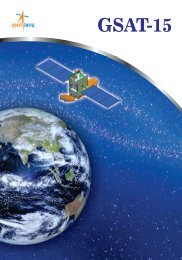INDIA’S INTENDED NATIONALLY DETERMINED CONTRIBUTION
1WsYDcS
1WsYDcS
Create successful ePaper yourself
Turn your PDF publications into a flip-book with our unique Google optimized e-Paper software.
development in the shortrun that needs to be factored in the policy matrix, where eradication<br />
of poverty is one of the foremost priorities.<br />
India accounts for 2.4% of the world surface area, but supports around 17.5% of the world<br />
population. It houses the largest proportion of global poor (30%), around 24% of the global<br />
population without access to electricity (304 million), about 30% of the global population<br />
relying on solid biomass for cooking and 92 million without access to safe drinking water.<br />
The average annual energy consumption in India in 2011 was only 0.6 tonnes of oil<br />
equivalent (toe) per capita as compared to global average of 1.88 toe per capita. It may also<br />
be noted that no country in the world has been able to achieve a Human Development<br />
Index of 0.9 or more without an annual energy availability of at least 4 toe per capita.<br />
With a HDI of 0.586 and global rank of 135, India has a lot to do to provide a dignified life to<br />
its population and meet their rightful aspirations.<br />
India is a developing country with a per capita GDP (nominal) of around USD 1408 per<br />
annum. However, this doesn’t reflect the wide disparities amongst its people and regions.<br />
Around 363 million people (30% of the population) live in poverty, about 1.77 million people<br />
are houseless and 4.9% of the population (aged 15 years and above) are unemployed. The per<br />
capita electricity consumption stands low at 917 kWh, which is barely one third of the<br />
world’s average consumption.<br />
A recent national socio-economic census indicates that economic and social deprivations are<br />
much higher in terms of availability of proper houses, access to education, lifeline availability<br />
of energy, and stable sources of income. This is more so in rural India where 48% of the<br />
households lack basic socio economic services and were categorized as deprived. India also<br />
has the largest cattle and buffalo population in the world of about 300 million, which faces<br />
multiple challenges including diseases, inadequate supply of fodder etc. as a result of<br />
changing climate.<br />
Given the development agenda in a democratic polity, the infrastructure deficit<br />
represented by different indicators, the pressures of urbanization and industrialization<br />
and the imperative of sustainable growth, India faces a formidable and complex<br />
challenge in working for economic progress towards a secure future for its citizens.<br />
Page 5 of 38



